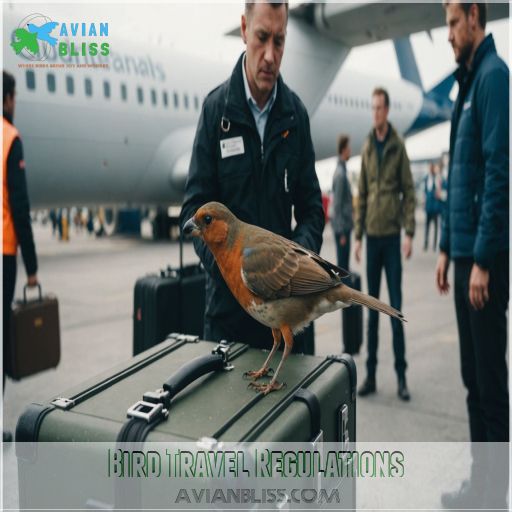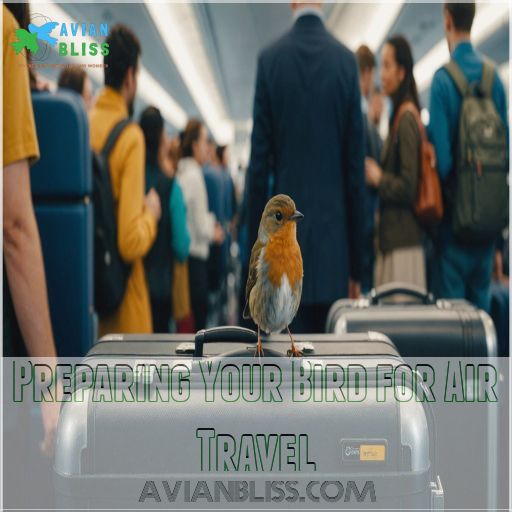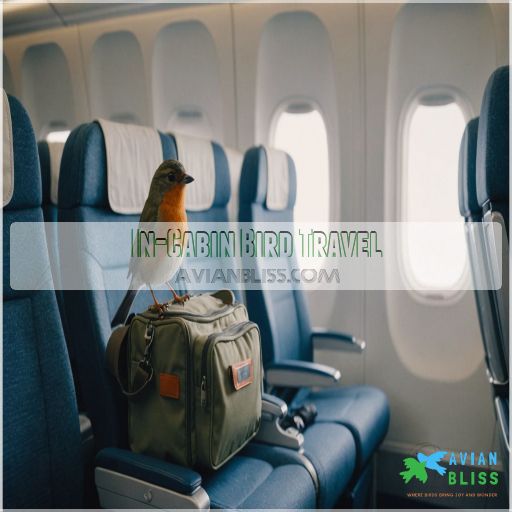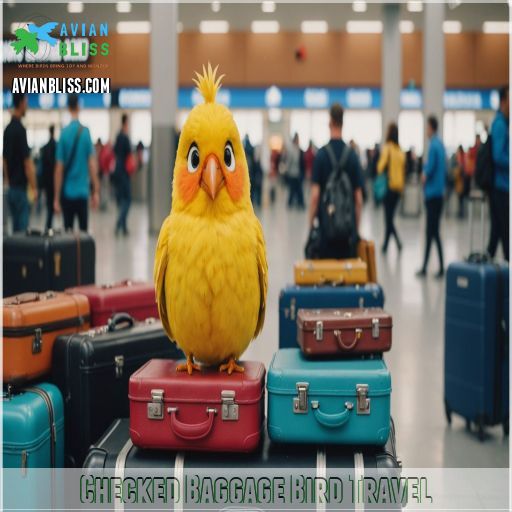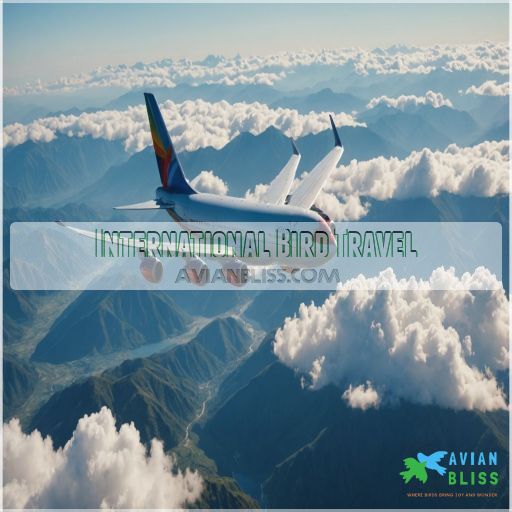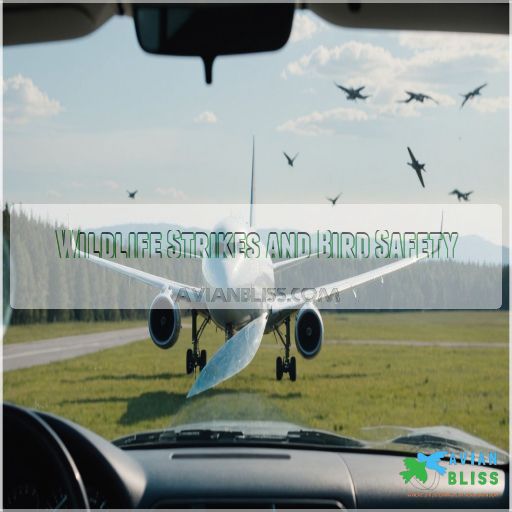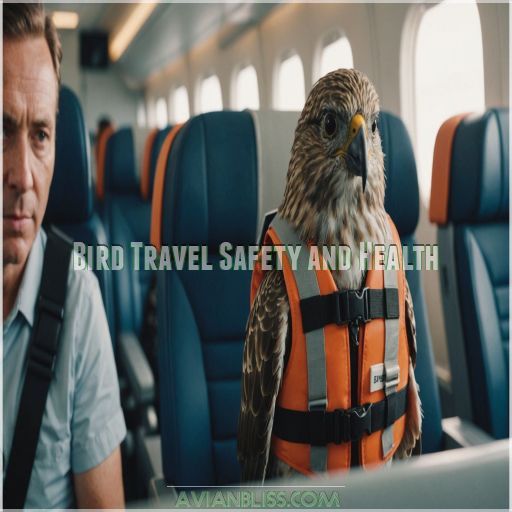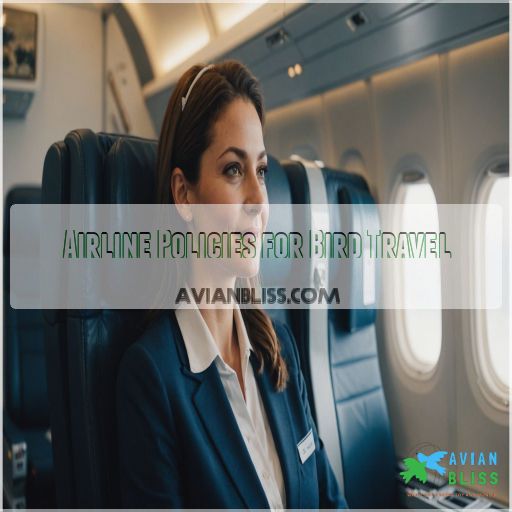This site is supported by our readers. We may earn a commission, at no cost to you, if you purchase through links.

Birds on planes need proper prep, so start with a vet check and simulate motion to ease anxiety. Birds can travel in-cabin if their carrier fits under the seat—which is great, as fruits and veggies make for excellent onboard snacks and hydration.
Direct flights are your best bet to minimize stress. Always stay informed about airline and country-specific regulations for smooth travel.
Curious about choosing the ideal travel cage or deciphering airline policies? Keep reading for expert tips! Choosing the right airline is also crucial, and knowing the airline’s species restrictions will make your life easier.
Table Of Contents
- Key Takeaways
- Bird Travel Regulations
- Preparing Your Bird for Air Travel
- Booking Bird Travel on Planes
- Bird Travel Cages and Carriers
- In-Cabin Bird Travel
- Checked Baggage Bird Travel
- International Bird Travel
- Wildlife Strikes and Bird Safety
- Bird Travel Safety and Health
- Airline Policies for Bird Travel
- Frequently Asked Questions (FAQs)
- Are birds allowed on airplanes?
- Do planes fly high to avoid birds?
- Can planes survive birds?
- How do planes affect birds?
- Can birds be photographed during flight?
- Are there age restrictions for young bird passengers?
- What sounds can birds make in transit?
- Can birds carry liquids while flying?
- Do birds need toys during travel?
- Conclusion
Key Takeaways
- Know Your Airline’s Bird Rules: Before you fly, dig into each airline’s rules for birds. Every airline has its quirks, from bird size restrictions to in-cabin or cargo options. Think of it as reading the fine print in the "birds and bees" section of air travel.
- Prep Your Bird for the Trip: Get your bird comfortable with travel by introducing them to the carrier early. Put familiar toys inside and maybe even a T-shirt with your scent. Like training for a marathon—they’ll need to warm up before the big race!
- Health and Documentation Are Key: Get a vet check to grab that all-important health certificate. It’s the golden ticket for crossing borders with your winged buddy—no surprises at customs when you’ve got your paperwork in order.
- Direct Flights and Timing Matter: Book direct flights to skip the chaos of layovers. And avoid peak travel seasons; your bird will thank you for dodging the airport madness. Think of it like booking a zen retreat instead of a bustling city tour.
Bird Travel Regulations
When you’re jet-setting with your feathered friend, figuring out how to travel together can be as tricky as teaching a parrot Shakespeare.
Understanding the ins and outs of bird travel regulations can help you both soar smoothly.
Like allowed species on planes or whether your tiny diva should ride in the cabin or cargo hold, knowing the rules can make a big difference.
Allowed Bird Species on Planes
Flying with pet birds can be a breeze if you know your species and airline restrictions.
Most flights welcome household birds like parakeets, but they must be odorless and quiet . Big no-nos include poultry and wild birds.
Choose a travel carrier that fits under the seat for smooth, stress-free bird travel.
Safe travels, tweethearts!
Country-Specific Regulations for Bird Travel
Figuring out bird travel regulations is like untangling headphones; patience and humor help.
Each country has its quirks, and details matter.
Consider these:
- Import permits: Essential for crossing borders.
- Quarantine policies: Be ready for your bird’s pit stop.
- Prohibited species: Double-check to avoid surprises.
- Health certificates: Make sure they’re in order.
Staying informed makes your flight smooth.
Airline Regulations for Bird Travel
Each airline has its own rules for bird travel, so be sure to check ahead.
Birds must fit in a travel carrier or cage, which should have identification material and breathable fabric.
Watch out for bird size limits, prohibited species, and pet fees.
Quarantine rules may apply, especially internationally.
As they say, forewarned is forearmed—preparation is key!
Cabin Vs. Cargo Hold Bird Travel
Is your bird ready to fly? Choosing between the cabin and cargo hold can feel like juggling avian aspirations!
Cabin travel is cozier but has size limits and airline fees . Cabin travel is a more intimate experience for birds, but it comes with restrictions.
Cargo holds offer more space but have higher stress levels and health risks, especially during long travel times or in extreme temperatures. It is crucial to weigh these factors against your bird’s specific needs.
Consider your bird’s needs and airline regulations before booking, ensuring a safe and smooth journey for your pet. This careful consideration is key to reducing stress levels.
Preparing Your Bird for Air Travel
Preparing your feathered friend for air travel takes some planning, but it’s worth the effort to make sure a smooth and stress-free journey.
From conditioning your bird to the travel cage to packing the essentials, these tips will help your winged companion take flight with ease.
These tips will cover various aspects of traveling with your bird, including preparing for the trip, choosing the right travel cage, and packing the essentials.
Conditioning Your Bird for Travel
Before your bird’s adventure takes flight, make sure it’s up to snuff for travel. Birds need a little TLC to handle air travel like pros.
- Schedule a pre-flight vet check for health assurance.
- Adjust diet gradually to ease digestion.
- Simulate flight time for motion comfort.
- Manage travel stress with familiar toys.
- Warm up those wings; conditioning will make travel a breeze.
Familiarizing Your Bird With the Travel Cage
Start by placing the travel cage near your bird’s usual hangout. Sprinkle some treats inside to entice curiosity. Make it feel homey with familiar scents and engaging toys.
It should become part of their playtime fun. Soon, your clever parrot will embrace it as a new play area, like a dog crate with an open invitation.
| Situation | Bird’s Feeling | Action |
|---|---|---|
| Sees new cage | Curious or wary | Offer treats |
| Enters cage | Safe or intrigued | Encourage play |
| Familiar toys | Comforted | Add to cage |
| Near home cage | Secure | Gradual intro |
| Smells familiar | Reassured | Use scents |
Providing Plenty of Food and Water During Travel
Air travel can be ruffling for birds, so pack plenty of their favorite food and water to keep them happy.
Use:
- Non-spill water containers
- Easy-to-eat food types
- Enough food quantity for the travel duration
- Secure food dishes to avoid turbulence spills
- A pinch of humor—perhaps tell your bird everyone’s “winging it” in the cabin!
Minimizing Stress for Your Bird During Travel
On your journey to make sure a smooth flight, remember: familiarization is key.
Acquaint your bird with its travel cage well ahead of time.
Toss in some favorite toys, and maybe a T-shirt with your scent to combat flight anxiety.
Create a calming pre-flight routine and avoid blackout dates or extreme weather conditions for a stress-free "birds on planes" experience.
Health Certificates and Vaccinations for Bird Travel
After reducing stress for your bird, it’s time to tackle health certificates and vaccinations.
Gather the required paperwork like a boss! Just be sure your bird’s up-to-date on its vaccination schedule, especially if you’re crossing borders—bald eagles aren’t the only ones flying into new territories.
Vet visits aren’t optional; they’re your passport to bird travel freedom! Keep it safe, folks, and remember that vet visits are the key to a stress-free travel experience with your vaccination schedule.
Booking Bird Travel on Planes
When you’re booking a bird’s flight, it’s like planning a vacation for a feathery friend who hates surprises.
Choose an airline that loves birds as much as you do, grab a direct flight to skip the stress of birdy layovers, and let your carrier know ahead of time.
Because even your parrot needs a reservation!
Choosing the Right Airline for Bird Travel
When selecting an airline for your feathered friend, consider their pet-friendly policies.
Some allow birds in the cabin, while others only accept them as checked baggage.
Review size limits, fees, and destination restrictions to make sure a smooth, stress-free journey for you and your beloved bird (Source).
Booking a Direct Flight for Your Bird
You’ve chosen an airline; now prioritize direct flights for stress reduction.
This minimizes layovers and keeps your bird in a travel cage for a shorter time, enhancing their comfort.
Check airline fees and make sure weight limits aren’t ruffling your feathers.
With shorter flight durations, your feathered friend will breeze through the journey, enjoying their airborne adventure, especially with stress reduction and a more comfortable experience in a travel cage for a shorter time .
Avoiding Peak Travel Seasons for Bird Travel
Traveling with your bird during off-peak seasons can save you money and stress.
Avoid holidays, when airports buzz like beehives, adding to bird travel stress.
Summer heat and winter chill impact your bird’s comfort, so spring and fall are perfect for gentle temperatures and off-season savings.
Think of it as booking a vacation during birds’ favorite weather!
Notifying the Airline About Your Bird
Booking a flight with your feathered friend? After choosing less hectic travel times, it’s time to notify the airline.
- Phone or email the airline early about your bird’s special needs.
- Confirm pet fees upfront to avoid surprises.
- Ensure cage size compliance for in-cabin comfort.
- Double-check carry-on rules for your peace of mind.
Obtaining a Health Certificate for Your Bird
Before jetting off with your feathery friend, you’ll need a health certificate from a USDA accredited veterinarian.
This certificate proves your bird’s fit for travel and isn’t a risk to others. Remember, it must be issued close to departure and involves specific tests, so plan ahead.
Keep your travel documents ready—flying’s all about timing!
Bird Travel Cages and Carriers
When flying with your feathered friend, choosing the right travel cage is essential for a smooth journey.
Don’t just wing it—make sure the cage is cozy, secure, and ready for takeoff so your bird feels like they’re flying first class!
They want to feel safe and comfortable, so the cage needs to be cozy.
Choosing the Right Bird Travel Cage
Getting your bird ready for a sky-high adventure starts with choosing the right travel cage.
Look for one that’s just the right size—roomy enough for comfort but compact enough to fit under an airline seat.
Make sure it has good ventilation, sturdy material, and safety features. With these aspects covered, your feathered friend will be flying in style.
Preparing the Travel Cage for Your Bird
Getting your bird’s travel cage ready is really important.
Make sure the cage is the right size – not too cramped, but not too spacious either . Add a sturdy perch at the perfect height, and pack plenty of food and water to keep your bird hydrated and nourished during the journey.
Line the bottom with absorbent bedding to keep things tidy.
With a little preparation, your bird will be ready to take flight. And to ensure a safe and enjoyable trip, it’s also crucial to have a little preparation.
Labeling and Identifying the Travel Cage
Tag your bird’s travel cage like you’d a treasured suitcase, packed with sentimental knick-knacks!
Clear cage labeling and travel tags are key.
Attach ID tags with your contact info, so your feathered friend isn’t left wondering.
Use vivid cage markings for quick identification.
Labels are akin to a birdie passport—ensuring safe passage through the hustle and bustle of travel.
Installing a Perch in the Travel Cage
When installing a perch in a bird travel cage, focus on stability and comfort.
Choose a perch material suited for your bird’s grip and comfort.
Securely attach the perch at an appropriate height, considering cage size and tail length .
Make sure the perch placement allows for easy movement without tail feathers touching the cage sides, minimizing stress.
Covering the Cage With Breathable Fabric
Once you’ve perched your feathered friend for travel, consider covering the cage with breathable fabric. Cotton blends are great for allowing air to flow through, keeping your bird comfortable and calm. Remember, some colors might suit your bird’s fancy better than others.
| Fabric Type | Ventilation | Bird Comfort |
|---|---|---|
| Cotton | High | Excellent |
| Polyester | Medium | Good |
| Wool | Low | Varied |
Don’t forget to check airline rules!
In-Cabin Bird Travel
If you’re planning to bring your feathered friend on a flight, understanding in-cabin travel rules is essential.
Let your bird enjoy the inflight movie next to you—as long as it behaves, there’s no need to worry about unexpected seat-kicking!
Airline Regulations for In-Cabin Bird Travel
Flying with your feathered friend in the cabin requires planning.
Airlines have quirky policies: cage size must fit under the seat, and your bird should be a quiet, unobtrusive traveler.
Some airlines, like Delta and Alaska, allow pet birds with an extra fee . Be sure to check noise limits, species restrictions, and whether emotional support birds are accepted!
Choosing a Suitable Bird Travel Cage for In-Cabin
You’ve secured airline approval for in-cabin bird travel; now let’s talk cages.
Size matters—compact enough to fit under the seat, but spacious for birdy comfort.
Durable material makes sure safety, while proper ventilation keeps your feathered friend breathing easy.
Opt for a Pak-o-Bird; it’s like first-class for birds—compact, comfy, and discreet.
Happy trails, or rather, flights!
Preparing Your Bird for In-Cabin Travel
Preparing your feathered friend for the in-cabin experience is key to a smooth flight.
Familiarize your bird with the travel cage well in advance, allowing them to get comfortable.
Make sure the cage is the right size, has perches, and is lined with absorbent material.
Bring your bird’s favorite treats to keep them calm and content during the journey.
Notifying the Airline About In-Cabin Bird Travel
After prepping your bird for the journey, it’s time to inform the airline. Check their requirements for cage size, bird temperament, and any travel restrictions.
Don’t forget health documents! A little friendly chit-chat with customer service never hurt—let them know you’re bringing a feathered friend on board, ensuring a smooth and delightful experience.
| Airline | Cage Size Requirements | Health Documents Required |
|---|---|---|
| Delta Airlines | Fits under seat | Yes |
| Alaska Airlines | As per seat size | Yes |
| Hawaiian Airlines | Under seat | Yes |
| Southwest | Under seat | Yes |
| United | Compact carrier | Yes |
Traveling With Your Bird in the Cabin
Something you mightn’t know is that traveling with your bird in the cabin can actually be quite the adventure. Birds are highly communicative animals and they mainly use songs and calls to convey messages, so you really need to monitor their behavior for signs of stress or anxiety during travel.
For instance, alarm calls can be loud and frequent, signaling distress, so a calming visual signal can help alleviate cabin stress. Make sure your bird’s travel cage fits the cabin size requirements to avoid surprises!
- Confirm airline fees for your feathered friend.
- Bring snacks—birds can be divas!
- Use calming covers for travel stress.
- Monitor your bird’s behavior for cabin comfort.
- Pack extra water for hydration.
Checked Baggage Bird Travel
If you’re considering flying with your feathered friend in checked baggage, there’s a lot to plan for your bird’s comfort and safety.
Let’s unravel how to navigate airline policies, pick the perfect travel cage, and make sure a smooth journey for your avian companion in the cargo hold.
Airline Regulations for Checked Baggage Bird Travel
Before your feathered friend takes off in checked baggage, check the cage size restrictions and make sure it’s mosquito-proof if you’re heading to Hawaii.
Notify the airline early—booking requirements are a must!
Watch out for temperature limits to keep your bird cool as a cucumber. Don’t wing it; those travel restrictions might cost extra fees for not meeting the temperature limits!
Choosing a Suitable Bird Travel Cage for Checked Baggage
You know what they say: the right bird cage can make or break a trip.
Choose a cage with ample size and sturdy materials, meeting airline rules.
Make sure there’s great ventilation for comfort and security, because nobody—feathered or not—likes cramped quarters, and plan for a journey that should be as smooth as a well-oiled machine.
Remember, your bird’s journey should be comfortable and secure, so plan accordingly.
Preparing Your Bird for Checked Baggage Travel
Prepare your feathered friend for a smooth checked baggage journey.
Familiarize them with their travel cage, ensuring it meets airline size requirements. Pack extra food and water to keep them hydrated and calm.
Don’t forget that health certificate – your vet can help you get your bird flight-ready. With a little preparation, your avian companion will soar through the skies in comfort.
Notifying the Airline About Checked Baggage Bird Travel
Armed with your bird’s documents, cage requirements in hand, and a sprinkle of humor, notify the airline about your feathered travel companion.
It’s like calling the babysitter—confirm those booking restrictions early.
Don’t forget the health certificate; it’s your bird’s passport.
Keep an eye on fees, too, or you might end up singing the budget blues! .
Traveling With Your Bird in the Cargo Hold
After notifying the airline, make sure your bird’s travel cage meets cargo hold requirements.
It shouldn’t resemble a sardine can—go for proper cage size to allow comfort.
Line the bottom with absorbent material for accidents, and add a familiar item to reduce stress.
Confirm temperature control with the airline to make sure your feathered friend’s trip avoids any overheated surprises.
International Bird Travel
Taking your bird on an international adventure?
It might be more complex than packing seeds and toys.
Know the rules, get a health certificate, and inform the airline to keep things flying smoothly!
Researching Country-Specific Regulations for Bird Travel
You’ve checked baggage for your bird, now let’s get savvy with country rules. Travel restrictions can be tricky!
Research import permits and quarantine rules to avoid surprises at customs.
Some countries ban certain birds due to disease concerns . So, check if your feathered friend is on the prohibited species list. Remember, not all birds earn a welcome mat!
Obtaining a Health Certificate for International Bird Travel
Getting a health certificate for international bird travel is like adding the final puzzle piece.
Visit your vet to make sure your feathered friend meets all health requirements.
Certificates can range in cost, depending on complexity.
Stay updated on country regulations and import restrictions to avoid any bird-brained surprises during your journey.
Every quack and chirp matters!
Notifying the Airline About International Bird Travel
So, you’ve got the health certificates sorted; now let’s give airlines a heads-up! It’s like throwing a party—you’ve got to tell the guests what’s cooking.
Contact them for:
- Quarantine rules
- Import restrictions
- Specific requirements
- Travel documents needed
- Costs involved
Getting in touch early helps navigate the maze of regulations smoother than a parrot’s aerial acrobatics!
Preparing Your Bird for International Travel
Preparing your bird for international travel requires some extra legwork.
First, research the quarantine regulations and health requirements of your destination country.
Obtain the necessary travel documents, like a health certificate signed by your vet.
Make sure your bird’s travel cage meets airline restrictions.
With a little planning, your feathered friend can take wing without a hitch.
Traveling With Your Bird Internationally
Taking your bird overseas is like planning a birdie adventure. Make sure freedom and safety by considering international bird quarantine and pet import restrictions.
- Avian health certificates
- Travel cage requirements
- Notifying airlines about feathered voyagers
- Managing airline fees
It might feel overwhelming, but with the right prep, you’ll both soar across borders worry-free!
Wildlife Strikes and Bird Safety
Traveling by air with your feathered friend means being aware of the buzz about wildlife strikes at airports.
Don’t worry—airlines and airports are tackling these high-flying issues with cutting-edge tech and creative solutions to keep everyone safe, including your beloved bird.
Risks of Wildlife Strikes on Planes
When flying with your feathered friend internationally, it’s essential to understand the risks of wildlife strikes on planes.
Bird strikes, especially during takeoff and landing, pose threats to engines and control surfaces.
Airport wildlife management employs radar systems, aircraft lighting, and drone technology to prevent collisions, ensuring everyone’s safety—bird and human alike!
Stay informed and fly safe!
Airports With the Most Wildlife Strikes
Flying might feel like a breeze, but managing wildlife strikes takes serious effort.
Airports like Denver International sit on bustling migratory routes .
With sophisticated wildlife management tactics, they aim to prevent pesky bird collisions and make sure aircraft remain safe.
Rest easy knowing safety standards are in place to minimize aircraft damage and keep your feathers unruffled.
Animals That Cause the Most Damage in Wildlife Strikes
Ever wonder which critters give airport safety nightmares?
Among the top culprits, deer strikes and bird species like turkey vultures can cause serious headaches—just imagine a feathery buffet gone rogue!
Eagles occasionally join the chaos, leading to damage that demands wildlife mitigation.
Airports worldwide combat these challenges daily, ensuring your sky-high adventures remain thrilling and safe.
Prevention Measures for Wildlife Strikes
Airport safety and wildlife management are essential for keeping birds off the runway and out of flight paths.
Here’s how you can help:
- Modify habitats around airports to discourage nesting.
- Use bird repellents and control measures.
- Implement effective reporting procedures.
- Foster awareness of bird hazards.
- Spread the word, not the feathers!
Technology for Detecting Birds in Flight Paths
Keeping your feathered friends safe in the skies is a top priority. Cutting-edge radar systems, AI-powered detection, and thermal imaging can all help spot birds before they become a hazard. With the right tech on your side, you’ll soar through the skies with confidence (Source).
| Technology | Capabilities | Advantages |
|---|---|---|
| Radar | Detects and tracks birds in real-time | Wide coverage, 24/7 monitoring |
| AI Vision | Identifies bird species and behaviors | Advanced analytics, automated alerts |
| Thermal | Sees birds in darkness and poor weather | Enhances situational awareness |
| Laser | Scans for foreign object debris (FOD) | Prevents runway incursions |
Bird Travel Safety and Health
When you’re flying with your feathered friend, bird travel safety and health should be your top concern.
Keep an eagle eye on their well-being and know what to do if your little aviator needs help mid-flight!
Risks of Air Travel for Birds
Flying with your feathered friend involves risks like stress from noise and temperature fluctuations, which can affect their health.
Sudden temperature changes might feel like stepping into an oven or freezer.
Birds may also face quarantine regulations, adding another layer of complexity.
So, plan ahead, and make sure your avian companion is as comfortable as a duck takes to water. Flying with your feathered friend can be challenging, but being prepared helps minimize risks like stress from noise and temperature fluctuations.
Monitoring Your Bird’s Health During Travel
Birds, like us, get their feathers ruffled during travel and need TLC. Watch for changes in behavior.
Check for excess flapping or stress squawks—it’s their version of travel anxiety.
Make sure they drink plenty of water and eat regularly to keep their spirits up.
Monitor flight health by peeking often, making sure they’re comfortable and have plenty of air.
Emergency Procedures for Bird Travel
If in-flight emergencies arise, like bird health issues or travel delays, keep calm.
Make sure your bird’s safe by checking for carrier malfunctions and lost luggage. Having backup plans, like extra supplies, is wise.
Remember, your bird’s a rock star in a travel cage—you’re the manager, on a mission to ensure an award-winning tour.
Airline Policies for Bird Travel
Figuring out airline policies for bird travel can feel like solving a feather-filled puzzle, but knowing what to expect helps.
Get ahead by checking rules, notifying airlines, and understanding fees to make sure your bird’s flight adventure goes smoothly.
Researching Airline Policies for Bird Travel
Before booking your feathered friend’s flight, take the time to thoroughly research each airline’s policies on transporting birds.
Policies can vary widely, from the types of birds allowed to size restrictions and fees.
Doing your homework upfront will help make for a smooth and stress-free journey for both you and your avian companion, and it is a key part of thoroughly research.
Obtaining Information on Bird Travel Policies
You’ve got your plan to fly with your feathered friend, but first, let’s talk info-gathering!
Check each airline’s restrictions; their website or a quick call usually reveals pet fees, health certificate needs, and travel cage requirements.
Don’t forget to charm the customer service reps—after all, they’re your inside scoop for smooth skies!
Notifying the Airline About Bird Travel
Planning to fly with your feathered friend?
Be sure to contact the airline early to inform them about your bird travel plans. Many airlines have specific bird travel requirements, including health certificates and cage size restrictions.
It’s like booking a spa visit—advance notice makes sure your pet gets its seat and avoids surprises mid-flight .
Understanding Airline Fees for Bird Travel
Flying with your feathered friend? Get ready to navigate the skies of airline fees and pet policies.
It’s no fluke that each carrier has its own nest of rules:
- Check baggage fees by airline
- Confirm cage size fits under seats
- Research travel insurance options
- Consider carry-on versus cargo
- Double-check country import restrictions
Enjoy a smooth trip!
Traveling With Your Bird on Different Airlines
Taking your feathered friend on an airplane? Each airline’s got quirky rules.
| Airline | Cage Requirements | Health Certificates |
|---|---|---|
| Delta | Carrier under seat | Yes |
| Hawaiian | Quiet, harmless bird | Yes |
| United | No poultry | Required for international |
Check for airline fees and travel restrictions—no wings in cargo during heat waves!
Frequently Asked Questions (FAQs)
Are birds allowed on airplanes?
Most airlines allow you to bring your feathered friend along for long as they’re a well-behaved "household bird" and fit in a carrier under your seat.
Do planes fly high to avoid birds?
Planes soar like eagles at high altitudes to dodge flying hazards like birds, ensuring safety with greater fuel efficiency.
It’s rare for birds to reach cruising altitudes, so you’re as safe as a bird in a nest (Source).
Can planes survive birds?
Airplanes can handle bird strikes quite well, with engines designed to withstand them.
It’s like dodging seagulls through a popcorn machine—messy but manageable.
Thankfully, extensive measures help guarantee aviation safety despite the occasional feathery encounter.
How do planes affect birds?
Imagine soaring skies interrupted by metallic giants.
When airplanes share airspace with birds, there’s a risk of collisions, sometimes fatal for birds and costly for airlines.
As seen in famed emergency landings and wildlife management efforts .
Can birds be photographed during flight?
Photographing birds in flight is totally doable!
Just master your camera’s autofocus, monitor lighting conditions, and practice panning techniques.
Remember, patience is key, and with persistence, you’ll snag that picture-perfect shot of birds on the wing.
Are there age restrictions for young bird passengers?
Birds must be at least 8 weeks old and weaned to wing their way onto flights.
These feathery flyers can join domestic U.S. trips but must skip the stowaway spots like Hawaii, Puerto Rico, and the Virgin Islands.
What sounds can birds make in transit?
When in transit, birds can make a variety of sounds, including flight calls, which are often higher-pitched and more frequent than songs.
Birds may vocalize more in response to airplane noise, a phenomenon observed in nearly a million recordings from 48 national parks.
Can birds carry liquids while flying?
You’re curious about birds carrying liquids mid-flight?
It’s a tricky question.
Birds don’t carry liquids like mammals do.
Instead, they efficiently excrete waste as a paste, keeping them lightweight for soaring adventures.
Do birds need toys during travel?
Imagine your bird’s travel experience like a road trip without tunes—pretty dull, right?
Toys aren’t essential for survival during travel, but they keep your bird entertained and mentally stimulated, especially on a long journey .
Conclusion
Imagine this: your bird soaring smoothly through the skies, much like a seasoned frequent flier.
While birds on planes might seem intimidating, equipped with the right knowledge, it becomes manageable. Make sure your feathered friend enjoys safe air travel by following airline guidelines, prepping the comfy travel cage, and keeping a health check.
Don’t fret—after all, it’s just another adventure in the trusted company of your avian companion. Now, get ready for takeoff with your winged buddy!

